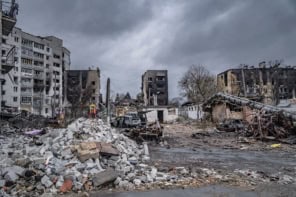
Extremes of heat are dangerous. Just how dangerous is still being established. But since heat waves are on the way, city-dwellers need to know.
Extremes of heat can break your heart. Climate change can kill. The risk of heart attack increases by every 5°C leap in temperature differential, according to new research.
That is: on a baking summer day there could be nearly twice as many heart attacks on those days when the temperature swings by 35° to 40°C than on days when there is no such wild fluctuation.
Studies of the link between heat and health matter, because the past decade in North America has now been confirmed as the hottest for 11,000 years.
Climate scientists have repeatedly warned of the dangers of ever more intense and frequent heat extremes as the global average temperatures creep up, and two new studies have identified different ways in which cities themselves can become danger zones for vulnerable people.
One is that, as regional climates change in response to ever-increasing combustion of fossil fuels, which then intensify the greenhouse gas ratios in the global atmosphere, cities in now-arid regions will suffer ever more severe heatwaves, even though their rural hinterlands may enjoy higher rainfall.
And the second is that, in some cities, urban planning may have already provided ways to intensify or mitigate the impact of summer heat waves. It’s a simple but unexpected outcome of atomic physics.
Increasing fluctuation
All four studies are evidence of the subtle and often intricate connections between human civilisation and climate, and of the consequences of the simple question: what happens to communities and landscapes as average temperatures go up?
“Global warming is expected to cause extreme weather events, which may, in turn, result in large day-to-day fluctuations in temperature,” said Hedvig Andersson, a cardiology researcher at the University of Michigan.
“Our study suggests that such fluctuations in outdoor temperature could potentially lead to an increased number of heart attacks and affect global cardiac health in the future.”
She told the American College of Cardiology 67th annual scientific session that she and colleagues looked at data from 30,000 patients treated in 45 Michigan hospitals between 2010 and 2016, and then matched the patients with temperature fluctuations on the day of the attack.
Such a study cannot prove that temperature swings actually cause attacks, but there is what scientists call an association: rapid and extreme fluctuations seem to be accompanied by more cases of myocardial infarction, a serious form of heart attack.
Urban vulnerability
That heat is dangerous is not a surprise: heatwaves in the last 30 years have risen three times faster than average temperatures as a whole, and one study has identified 27 different ways in which heat waves can kill. And the greatest concentrations of potential victims will be in the cities.
The crowded urban spaces of America and Europe spread across landscapes warmer than at any time since the end of the Ice Age. US researchers report in the journal Nature that they collected fossil pollens from 642 ponds and lake beds across Europe and North America, to provide a record of local temperature shifts in the last 11,700 years, to conclude that – without global warming as a consequence of profligate human use of fossil fuels – the world ought to be in a cool phase.
“It does show that what has happened in the last 30 years — a warming trend — puts us outside of all but the most extreme single years every 500 years since the Ice Age. The last 10 years have, on average, been as warm as a normal one year in 500 warm spell,” said Bryan Shuman, an earth scientist at the University of Wyoming, and one of the authors.
Whatever the average regional temperature, it’s hotter in the cities, because concentrations of traffic, business, heating, cooking, lighting and air conditioning generate what has become known as the urban heat island effect: what makes this worse is that the asphalt, tarmacadam, stone, brick, glass and tile of which cities are made absorb radiation but prevent ground evaporation as a natural cooling device.
Researchers from Princeton University report in the journal Environmental Research Letters that they considered how future heat waves will play into the urban heat island effect in 50 US cities.
For the rest of this century, cities in the east and southeast of the US will be more severely affected: less so the cities in the arid parts of the American west.
But by 2100, this could change dramatically. Rainfall and heat extremes will increase. Cities such as Phoenix, Arizona will continue to face water shortages – once again, all that impermeable concrete and sealed highway – but climate change could make the surrounding countryside somewhat moister.
The message, once again, is that what keeps a city cool is moisture: the vapour evaporated from canals and rivers or transpired through green parks and treelined boulevards.
“Given that 50% of the world’s population currently lives in cities, and that percentage is projected to increase to 70% by year 2050, there is a pressing need to understand how cities and landscapes are affected by heat waves,” said Lei Zhao of Princeton’s Woodrow Wilson School of Public and International Affairs.
“Our study explains why cities suffer even more during extreme heat events and highlights the heat risks that urban residents face now and in the projected future.”
Seeking mitigation
The researchers say the hunt should be on for heat mitigation strategies. But a surprising study in the journal Physical Review Letters suggests that some of the problems – and the solution – may have already been built into the fabric of the modern metropolis.
A team of materials scientists and engineers simply considered the city as crystalline or glass-like: that is, was the city laid out on a planned, orderly grid system? Or did it just grow up, in an organic, disorderly fashion?
They applied the tools of classical physics normally used to analyse atomic structures. They looked at satellite images of 47 cities in the US and beyond, and graded them according to their order, or disorder. Grid cities absorbed heat compared to their surroundings far faster than the so-called glass-like cities.
Since urban populations are growing, and new cities springing up everywhere, classical physics can help in unexpected ways. “If you’re planning a new section of Phoenix,” said Roland Pellenq of the Massachusetts Institute of Technology, “you don’t want to build on a grid, since it’s already a very hot place. But somewhere in Canada, a mayor may say no, we’ll choose to use the grid, to keep the city warmer.”
The effects are significant. He and colleagues found, for example, that in the state of Florida alone urban heat island effects cause an estimated $400 million in excess costs for air conditioning. “This gives a strategy for urban planners,” he says. – Climate News Network
• This report was first published in Climate News Network



